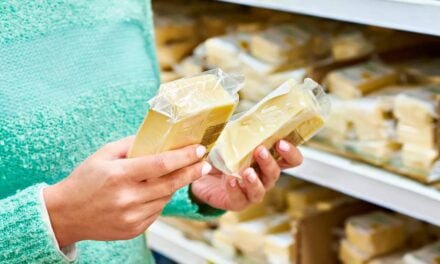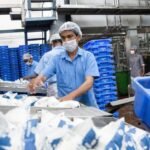Packaging plays a crucial role in enhancing the shelf life of meat and meat products. By protecting them from environmental factors, packaging helps maintain freshness. Suresh Bhise and Preeti Shukla, explain here how modern packaging techniques are specifically designed to reduce spoilage and extend shelf life of meat and meat products, ensuring that consumers enjoy high-quality meat for longer periods.
Table of Contents
In most developing countries meat carcasses are handled and stored either without or with only minimal refrigeration. A fast-turnover system is used, ensuring that meat slaughtered during the night and morning is sold and consumed the same day. This well-proven traditional method functions satisfactorily because, in the short period between slaughtering and consumption, micro-organisms cannot increase to the extent of spoiling the meat and making it inedible. This system is eminently suitable for rural villages and small towns in many developing countries, particularly because local cooking habits do not call for ripened and tender meat.
This fast turnover of meat normally does not lead to meat spoilage, although massive contamination during slaughtering and meat handling frequently occur. Fortunately, in most cases, toxic micro-organisms do not develop to such an extent to threaten consumers’ health, provided that the time between slaughter and meat cooking is short and cooking is done properly and with sufficiently high temperatures.

In traditional meat handling, fresh meat is generally not packaged at all or just wrapped in paper, leaves, etc. Meat, traditionally preserved by drying, is sometimes packaged in linen bags, baskets or pottery to facilitate storage and transport and to provide some kind of protection against dirt, insects, etc.
With higher concentrations of population, however, this traditional system now becomes outmoded in some places in developing countries because more time is needed between slaughtering and ultimate consumption. Meat frequently has to be stored, transported, prepared and distributed through a retailer or supermarket, all of which is considerably time-consuming.
To safeguard fresh meat during this extended time, certain methods of preservation have to be applied. Refrigeration is the obvious solution, but this is expensive and therefore frequently not available in developing countries. Energy-saving storage methods are therefore particularly relevant in underdeveloped areas. For both methods, either using the refrigeration technology or energy-saving methods to extend the shelf life of meat and meat products, proper packaging has an important part to play. For instance, vacuum-packaging, which minimizes oxygen exposure, is highlighted in Nanotechnology for Safe Meat Packaging as a revolutionary method.
Purpose of fresh and processed meat packaging
The purpose of packaging is primarily to protect foodstuffs during the distribution process, including storage and transport, from contamination by dirt, micro-organisms, moulds, yeasts, parasites, toxic substances or those influences affecting smell and taste or causing loss of moisture. Meat packaging should help to prevent spoilage, weight losses and enhance customer acceptability.
Simple packaging without further treatments is less effective in prolonging the shelf life of meat and meat products. Frequently full advantage of meat packaging can only be achieved in combination with preservation methods.
Factors affecting the shelf life of meat and meat products
Though meat handling, storage, and consumption may differ from one place to another, the factors limiting the shelf-life of these products are the same. There are endogenous factors and exogenous factors.
Endogenous factors
- pH-value or the degree of acidity of the product
- aw value or the amount of moisture available in the product
- Exogenous factors
- Oxygen (from the air)
- Micro-organisms
- Temperature
- Light
- Evaporation
- Desiccation
Combined effect of pH- and Aw-value
Generally speaking, the shelf life of meat and meat products will be longer the lower the pH-value and/or aw-value. Both factors (either pH or aw alone or the two together) have a decisive influence on the growth of micro-organisms in food. However, there are limits for most meat products regarding decreased pH-value and aw-value, particularly for organoleptic reasons. Except for some special products, consumers do not want meat products to be excessively acidic or dry.

Uncanned meat products can be classified into three storage groups according to their pH and aw. Each group requires different storage conditions.
Highly perishable meat products have a pH-value above 5.2 and an aw-value above 0.95; refrigeration at or below +5°C is needed. These are raw fresh meat (without additives), bologna-type sausages, cooked sausages, and cooked ham.
Perishable meat products have a pH-value below 5.2 or an aw-value below 0.95. Refrigeration at or below +10°C is needed to keep them stable. Products such as meat or poultry pieces in vinegar jelly (acid) and semi-dry sausages or hams belong to this group.
Shelf-stable products have a pH-value of or below 5.2 and an aw-value of or below 0.95, or only a pH-value below 5.0, or only an aw-value below 0.91. No refrigeration is required in these cases, the products remaining stable under ambient temperatures. The most common products in this group are the various kinds of dried meat.
Under the above conditions, no microbial growth in meat and meat products will occur. However, this does not mean that the products remain stable for an undetermined period. Their shelf-life will be limited by chemical or physical deterioration, by rancidity and discoloration. In this situation, the product quality will benefit from the application of suitable packaging materials, which reduce the physical and chemical influences on the product or protect the product completely. The following noxious influences may occur.
Effect of Oxygen on meat and meat products
The oxygen content in the air is about 20 percent. If oxygen affects meat and meat products during prolonged storage periods, it will change the red colour into grey or green and cause oxidation and rancidity of fats with undesirable off-flavors.
The foils used for food packaging differ in their permeability to oxygen. The lower the oxygen permeability of the meat packaging material, the more efficient will be the protection of product quality. The best protection will be achieved using oxygen-proof packaging films together with vacuum packaging of the product. This ensures that practically no oxygen is left in the package and no oxygen will penetrate from the air into the product.
Effect of Light meat and meat products
The prolonged exposure of meat and meat products to daylight or artificial light accelerates oxidation and rancidity because light provides the energy for these processes. Transparent packaging films give no protection against light influences. Therefore, for products under strong light exposure, colored or opaque films should be preferred. Films laminated with aluminum foil are impermeable to light. Products in transparent packaging film are sufficiently protected when kept in the dark or under moderate illumination.
Effect of Evaporation meat and meat products
Fresh foods with relatively high moisture content such as meat, fresh sausages, cooked ham, etc. will have considerable losses of weight and quality by evaporation during storage if they are not packed. The meat packaging material must, therefore, be sufficiently vapour-proof. Most plastic films used for food packaging comply with this requirement.
Effect of Secondary contamination meat and meat products
During slaughtering, carcass dressing, meat cutting and/or processing, the contamination of meat to some extent cannot be avoided. The further growth of micro-organisms in meat and meat products cannot be stopped through packaging only. However, secondary contamination of these foods, for example by contact with dust, dirty surfaces and hands, can definitely be prevented through proper packaging, preferably with plastic films which are absolutely impervious to agents causing secondary contamination. These advancements align with sustainable food packaging practices detailed in Sustainable Packaging: Future Prospects.
Suitable materials and equipment for meat packaging
Packaging films can be subdivided into cellulose films, plastic films and aluminum foil. They can either be used as mono films or as two or more different films laminated together. These materials differ in:
- Oxygen permeability
- Water vapor barrier
- Resistance to hot and cold temperatures
- Mechanical strength
Nearly all available films are of thermoplastic materials, and therefore heat sealable, resulting in hermetically sealed plastic pouches, bags, etc.
A high oxygen barrier is important in the application of films for packaging meat and meat products. Films made of polyvinylchloride (PVC), polyethylene (PE) or polypropylene (PP) have a relatively high oxygen permeability, whereas polyvinylidene chloride (PVDC), polyester (PETP), polyamide (PA) and cellulose film (ZG) are less or almost non-permeable to oxygen. The latter materials are therefore better suited for packaging meat and meat products. However, the materials of the first group are frequently used as laminates with materials of the second group to achieve special effects regarding mechanical strength, heat sealing properties or making the package practically impermeable to both oxygen and water vapour.
For the efficient utilization of these materials, air must be drawn out completely from the packages with the meat product (“vacuum-packaging”) and the package should be hermetically closed by heat sealing or metal clip. Vacuum-packaging will inhibit the growth of yeasts, moulds, and most aerobic bacteria under refrigeration temperatures. However, facultative anaerobes such as acid-producing bacteria grow freely under adequate aw-conditions.
These micro-organisms do not threaten the health of consumers but may affect the quality of the products by negatively influencing colour and taste. Therefore efforts should be made to keep the initial number of bacteria low, which can be obtained by simple hygienic measures during cutting and packaging, such as frequent hand washing, clean tools, and clean tables.
The above general considerations refer to vacuum-packaged meat and meat products with high moisture content. The situation is different for the traditionally preserved meat and meat products. All these products are shelf-stable because of their low water activity and therefore do not require refrigeration. They are partially dried in the sun, or others are dried and smoked over a wood fire.
These low-moisture products are hygroscopic and should be protected in the case of high air humidity. Traditional wrapping methods using paper, jute or linen will not inhibit the penetration of water vapour. However, a simple polyethylene bag is sufficient as a water vapour barrier, but care must be taken that the bag is tightly closed. If plastic bags are used for packing, then the pieces of dry meat should be cut to a certain length so that they can be better arranged in the bags. The bag should be bound with rope, rubber or cello-tape. Bags stuffed with meat in this way are best stacked into a carton. Vacuum chamber machine. The lid is opened after evacuating and heat sealing of packages containing meat cuts and pieces of sausage.
Longer storage times for traditionally preserved dried meat can be achieved with vacuum-packaging in laminated films, which protect against humidity and oxidation by oxygen from the atmosphere. Vacuum-packaging can also gain importance for traditionally preserved products. Although they are shelf-stable, exposure of these products to oxygen and the humidity of the surrounding atmosphere will cause unfavorable alterations (rancidity, loss of flavour and growth of certain micro-organisms) over the long term. Air and vapour-tight packaging will ensure a prolonged shelf-life.
Simple vacuum-packaging machines, suited to less developed regions, are available. They consist of a chamber with a removable lid so that the plastic pouch or bag containing the product can be placed inside the chamber, which is evacuated with an electrically driven vacuum pump. By closing the lid, air can be drawn out of the chamber and also out of the open bag. While still in the vacuum chamber, the bag is hermetically closed by heat sealing using a manual or automatic electrically heated sealing device. After being sealed the bag can be exposed to ambient conditions without air penetrating the package.

FAQs on Boosting Shelf Life of Meat
What are the benefits of a fast-turnover meat handling system?
It prevents spoilage and ensures meat is consumed before microbial growth becomes a health risk.
Why is refrigeration not always feasible in developing countries?
Refrigeration is expensive and often unavailable, making energy-saving alternatives vital.
What are the key factors affecting the shelf life of meat and meat products?
Endogenous factors (pH-value, water activity) and exogenous factors (oxygen, temperature, light, evaporation).
How does vacuum packaging benefit meat storage?
It removes oxygen, inhibiting microbial growth and preserving meat quality.
What materials are commonly used for meat packaging?
Plastic films like polyethylene, polyvinylchloride, and advanced options like polyvinylidene chloride are preferred.
What role does packaging play in preventing meat contamination?
Proper packaging protects meat from dust, dirt, and secondary contamination during handling and storage.
Why is light exposure detrimental to meat products?
Light accelerates oxidation and rancidity, negatively affecting meat color and flavor.
What sustainable packaging solutions are available for meat products?
Options include biodegradable packaging, vacuum-packaging, and laminated films to ensure long shelf life and reduced environmental impact.
Have a news or topic to share with industry? Write to us editorial@pfionline.com















